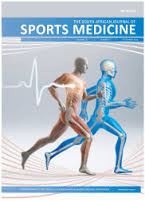Accelerometery vs. video-derived stroke parameters in high-level swimmers
DOI:
https://doi.org/10.17159/2078-516X/2021/v33i1a9483Abstract
Background: Swimming is a multifaceted sport with nuanced performance parameters that tend to vary according to the swimmer’s stroke style. The extraction and analyses of swim parameters, such as lap time (LT), stroke length (SL), stroke rate (SR) and velocity are time-consuming. This may be eased and to some extent automated by the use of cost-effective tri- axial accelerometers.
Objectives: To determine the validity of tri-axial accelerometers across all four stroke styles, and to investigate kinematic differences in stroke styles using accelerometer- based data.
Methods: Twelve elite swimmers were recruited for the study. The group consisted of five male (age: 22.2 ± 2.6 years; height: 1.84 ± 0.08 m; weight: 76.2 ± 3.6 kg) and seven female (age: 20.7 ± 2.1 years; height: 1.68 ± 0.08 cm; weight: 62.0 ± 6.3 kg) swimmers.
Results: There was a small but significant bias for accelerometery data compared to video data across most parameters and stroke styles except for stroke length and stroke count (p > 0.05). However, accelerometery-derived SR, SL and velocity can be considered practically useful based on the training requirements of coaches. Parameters derived from video analysis compared to accelerometery were highly correlated (r > 0.91) and therefore consistent regardless of the method of analysis.
Conclusion: Although slight differences were present between the video and accelerometer data, these differences were not practically meaningful.
Downloads
Downloads
Published
Issue
Section
License
The South African Journal of Sports Medicine reserves copyright of the material published. The work is licensed under a Creative Commons Attribution 4.0 (CC BY 4.0) International License. Material submitted for publication in the South African Journal of Sports Medicine is accepted provided it has not been published elsewhere. The South African Journal of Sports Medicine does not hold itself responsible for statements made by the authors.
How to Cite
- Abstract 460
- PDF 465






.png)